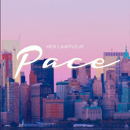Name: Roberto C. Chavez
Age: 24
Year: 2013
Minor/Major: History Major; Queer Studies Minor, Peace & Justice Studies Minor
Hometown: New York City
Horoscope Sign: Leo
Campus Involvement: Pace Stonewall Coalition (Vice President), 2012 Orientation Leader, CCAR (Student Assistant)
What was your most memorable experience of being a student at Pace? “When I was an Orientation Leader the summer of 2012, I was very vocal to my students about being a part of Stonewall Coalition and the LGBTQA Center. My Orientation Team — which was comprised of gay, bi, and straight leaders — would often send students my way if they had a question about the LGBTQ community and activism on campus.”
I remember many times on the boat cruises around Manhattan, students would talk to me about their coming out experiences, what they left behind back home, and their hopes and fears for the future. It was very heartwarming and overwhelming to share such tender, powerful moments with students. There were definitely many tears shed.”
What kind of volunteer work do you do at Pace? “I volunteer at the LGBTQA & Social Justice Center. Last semester I assisted a clothing drive for homeless LGBTQ youth that the Center was running. With the help of the Center Student Assistants, I created “Tabling Tuesdays with Roberto” to promote the clothing drive and let passersby know about what resources the Center provides. I also had the honor of being the emcee for the annual ‘Coming Out Day Fair’ in October. I just like interacting with students whenever I can.”
How has working with Pace’s LGBTQA and Social Justice Center influenced your work as a social rights activist? “Ever since the Center was formed in 2011, I started learning a great deal about civic engagement and social justice. I found a physical space where I could talk to my peers and others about issues that affect the queer community: coming out, stereotypes, safer sex, art and advocacy, and more.
I also started gaining a wider perspective of our queer community; for example, some student leaders would be out and open at Pace, but then have to go back into the closet whenever they visited their families. Hearing such stories and struggles made me reconsider the binary of “being out” and “being in the closet,” and how it is not always so simple because of prejudice within families, workplaces, or our communities.
You can say the relationships that I have made at the Center have made me more empathetic as an activist and have helped me understand how our different struggles are interconnected.”
What is your hope for students who may be thinking of getting involved with the Center? “Go in and check out the Center’s books, have some candy in the lounge, and chat with the friendly staff. See a space that students, alumni, faculty, and staff tirelessly advocated for. You are connected to that history and to that desire to find a community. Maybe you’ll make a friend, be able to create some art, learn something new about yourself or your peers, and more.”
How important is it to you that students here at Pace have a space like the LGBTQA center, that allows them to celebrate who they are and to help others do the same? “I feel that it is important for students to be able to have that space to be themselves and express themselves. The Center provides a trained staff to help students whenever they are facing any issues relating to their sexuality or their gender identity (like homophobia, biphobia, transphobia, etc.). The Center also gives students a place where they can study, wind down between classes, and talk to their contemporaries. You can have humorous, light-hearted conversations there, as well as serious, thought-provoking discussions. It also can connect students to the greater LGBTQA community in New York City and beyond.”
Can you tell us about the work that you do at the New York Transit Museum? What is your favorite part about working there? “I am a part-time educator at the New York Transit Museum. I lead school group tours (pre-K to Grade 12), guide learners/visitors with special needs, develop lesson plans with the D.O.E. Scope and Sequence in mind, and assist birthday parties on the weekends.
What is exciting about the museum is that it used to be an actual subway station, so visitors can board historic subway and elevated train cars and explore them!
One of my favorite things to do is read children’s books to families. Not to mention, seeing the surprise and the joy on a child’s face upon learning the museum was a subway station is quite priceless!”
A fun part of the Museum that people may not know about is Poetry in Motion. Can you tell us a little more about what that is? “Poetry in Motion was started by the Metropolitan Transportation Authority (MTA) and the Poetry Society of America in 1992. Riders can read poems on their commute in cities across the country. Some of the museum’s modern train cars have Poetry in Motion car-cards. They were used in the past summer program where campers made their own poetry together. I personally believe Poetry in Motion can be entertaining during our commutes and can inspire the poet inside all of us.”
Have you ever written a Poetry in Motion piece? “I did write a piece called “Ode to the Subway Rat” but I can’t remember it for the life of me. I don’t think commuters need a reminder of rodents, though.”

